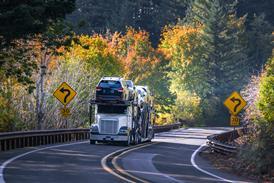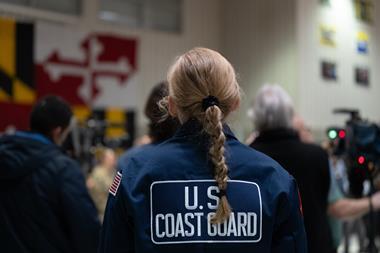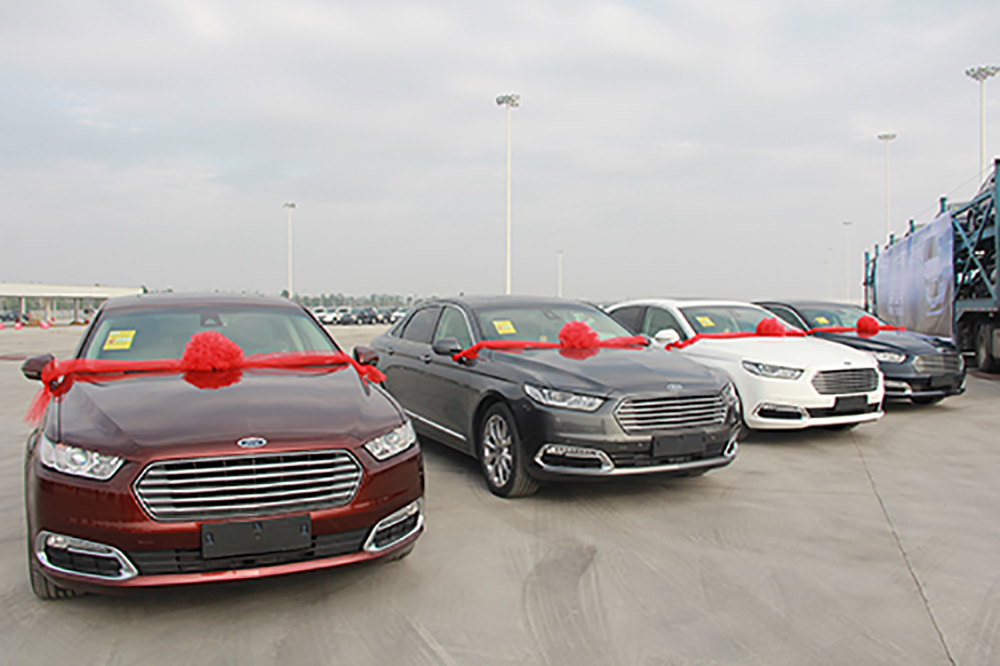 Bob Laurila, director of material planning and logistics in Asia Pacific, discusses how Ford is adapting its organisation and its systems to manage the region’s changing vehicle flows.
Bob Laurila, director of material planning and logistics in Asia Pacific, discusses how Ford is adapting its organisation and its systems to manage the region’s changing vehicle flows.
Asia Pacific is becoming one of Ford Motor Company’s most dynamic and important regions for vehicle logistics. A quick glance at the map reveals its obvious distribution complexity, whether it is China’s scale, fragmented markets in South-East Asia, the sprawling potential of India, or the remote but important territories of Australia and New Zealand.
Of the company’s five global regions, Asia Pacific has arguably the widest disparities in development and infrastructure. Whereas during 2015 Ford opened new plants in China and India, in Australia it will soon close its only factory. While Thailand and Australia have port and logistics facilities that are among the best in the world, India lags in capacity, loading times and velocity. Asia also has a particularly complicated web of customs regimes and local transport laws that can add significant costs.
Managing logistics in such a scenario is never going to be easy, especially in an economic climate that has recently seen slowdowns in China, political instability in Thailand, sales stagnation in India, and Australia hurt by falling commodity prices. But for Robert (Bob) Laurila and his material planning and logistics (MP&L) team, the terrain is as rich with promise as it is with challenges for outbound logistics. In particular, Asia Pacific is at the centre of a shift towards regional and global exports and imports, with supply and brand impacts across the region.
In this story...
That is not to ignore the importance of the Chinese domestic market, where Ford has six joint-venture assembly plants and sold more than 1.1m units in 2014 (sales through November in 2015 put it on pace for a similar number for the full year). However, the carmaker’s transformation in the wider region has been about more than adding production capacity; equally important has been the development of more sophisticated planning, creating more balance in transport modes, and increasing inventory visibility.
Such attention to vehicle logistics reflects the extension of a brand experience for Ford, enhancing the buying process for a new reach of customers with products like Lincoln and Mustang, which had not previously been distributed so widely. It joins vehicles like the Chicago, Illinois-built Explorer full-size SUV in a distribution chain over which MP&L takes higher levels of control and monitoring for the Chinese market, from global factories to local dealers. Although the volumes are not yet huge, they are rising fast; for example, Ford imports to China for 2014 jumped 13% to above 37,000 units, and are expected to rise substantially across Asia Pacific for the rest of the decade.
New flows will grow in multiple directions. Laurila expects India to be a critical export hub for Ford in the future. The carmaker opened its second plant in early 2015, in Sanand, in the western state of Gujarat, complementing Chennai in the south. From Sanand, Ford has started exporting the Figo to Africa and Mexico. Separately, Ford has exported the EcoSport SUV to Europe since 2014 from Chennai.
Other exports and imports are reshaping Ford’s business in the region, including the launch of the new Ranger and Everest pickup truck from the AutoAlliance plant in Rayong, Thailand, which are sent to 80 markets. Ranger exports are so strong that in November, Ford announced that it would add capacity to also build the model at its fully owned Ford Thailand Manufacturing (FTM) plant in Rayong. FTM exports of the Ecosport, Focus and Fiesta are also growing within Asia.

Building a new organisationThese vehicle launches connect Ford’s Asia Pacific network directly with plants and markets in various regions, including the US, Mexico and Europe, in a supply chain increasingly integrated into Ford’s global visibility and distribution systems. Facing this growing complexity, in 2015 Bob Laurila created a dedicated organisation to manage finished vehicle logistics in Asia Pacific within the MP&L department.
While Ford always had staff working on outbound logistics in the region, Laurila saw a need for a centralised team to pull together planning for regional and joint-venture plants, imports and exports. “What changed in 2015 was that I realised our imports and exports were growing so much, with rising freight, duty and inventory costs, that we needed a dedicated team to increase our visibility and performance,” he says. “That makes Asia Pacific consistent with Ford’s logistics management in North America and Europe, which have been organised that way for some time.”
Yibing Wang, finished vehicle distribution manager for Asia Pacific, heads up the new department after previously managing inbound and outbound for China. In line with the MP&L department in Asia Pacific, Yibing oversees managers on the ground in China and Thailand, with support staff in the city of Nanjing and at Ford’s Asia Pacific headquarters in Shanghai, where he is based. Yibing has two principal managers who oversee distribution, import and export operations: Richard Li, based in Nanjing, is vehicle distribution manager for Greater China, including Taiwan and Hong Kong; and Richard Wyatt, based at Ford’s plant in Rayong, is vehicle logistics manager for Asia Pacific markets except Greater China.
Yibing Wang points to cross-shipping developments as his main focus, including rising imports from Europe and North America, and growing exports out of India and Thailand (joint-venture production in China remains entirely focused on the domestic market). He also highlights that the region’s quality and delivery expectations are in line with global Ford standards.
“For domestic markets like China, we manage the yard operations, yard safety, and look after on-time delivery and optimising vehicle delivery by different modes like rail, barge and sea,” says Yibing.
The vehicle logistics department fits into the wider Asia Pacific MP&L organisation of 450 salaried employees under Bob Laurila, who has responsibility across Ford’s inbound and outbound supply chain, including strategic aspects of vehicle distribution like production scheduling, inventory management, customs and export operations. Laurila, a 27-year veteran at Ford, has spent most of his career in manufacturing and MP&L across plants and regional-level roles in North America. He has been in Asia for four years, first as MP&L operations director for India and ASEAN, based in Thailand, before moving to Shanghai.
Among the key roles for MP&L’s outbound management is planning, including distribution network design to support and maximise load building, routing and transport modes. This work comes into play especially for new model launches, in which MP&L runs detailed studies of distribution patterns and freight costs. Day-to-day operations are managed by local teams at the plants, with regional MP&L staff contributing to central network and distribution planning.
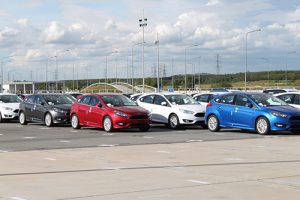 All Ford plant yards, whether at wholly owned sites like at FTM in Thailand (above), or at JVs, have global standards for safety, storage, parking, surface striping and maintenance
All Ford plant yards, whether at wholly owned sites like at FTM in Thailand (above), or at JVs, have global standards for safety, storage, parking, surface striping and maintenanceWhile joint ventures complicate operations in Asia Pacific, especially in China, MP&L’s management of these vehicles does not differ much compared to Ford entities. In China, Ford has four plants (and a fifth under development) with with its 50:50 joint venture with Changan, and two plants with Jiangling, in which it owns a 32% stake. It also has its 50%-owned AutoAlliance with Mazda in Thailand, plus majority-controlled ventures in Taiwan and Vietnam.
“Our roles at JVs are similar, although we get a bit less involved in how we define operations than we do for our direct affiliates,” Laurila says. “We do the planning for the plants centrally, and then the regional teams interface with the plant-based resources, whether for an affiliate or a JV.”
In China, for example, where Changan Ford (CAF) or Jiangling (JMC) have day-to-day responsibility to distribute the vehicles, they interface with Richard Li. When Ford launches new models from these plants, his team determines the best transport modes and compound locations based on cost, space and capacity. “We work on high-level planning and collaborate with JVs for optimisations, but we don’t work on their daily operations,” says Li.
All of Ford’s vehicle inventory and related costs are part of MP&L’s budget, which puts huge emphasis on tracking data from plants, JVs and regional teams on storage, dispatches, and freight costs, all of which influences scheduling. “We spend a lot of time working with the plants on managing their yard inventory, and working with our sales team to get our production schedules aligned with forecasts and making sure we don’t have growing yard stock,” Laurila says.
He points to progress over the past years in managing inventory levels, although he admits forecasting is still difficult, particularly in China and India. “Some of that is industry driven, some of it is economic factors, but we can get better at our sales forecasting, although we have made progress,” he says.
Moving towards total visionAlong with bringing down costs, the rise of import and export flows across Asia Pacific is putting more emphasis on inventory control and visibility down to the level of the vehicle identification number (VIN). Such visibility is intended to help Ford improve delivery estimates, reduce costs and anticipate potential disruptions or changes in the supply chain. These connections hinge more than ever on global IT systems and processes.
Many of MP&L’s approaches are already global in scope, including for shipping, handling and inspection processes. Richard Wyatt says that all of Ford’s yards have global standards for safety, storage, vehicle parking, surface striping and maintenance, including defined procedures for handling low voltage batteries, or for vehicles with ‘extended stays’ in compounds. “Asia Pacific is not unique. We follow global Ford processes for quality and process,” says Wyatt.
The JVs also use Ford standards across vehicle yards and compounds, according to Richard Li, right down to lighting requirements, safety signs, painting guidelines and parking.
 Click to enlarge
Click to enlargeHowever, Ford has historically had different IT systems to track inventory and vehicles in transit. Over the past decade, as part of the ‘One Ford’ strategy and the rollout of global vehicle models, the OEM has moved towards global operating systems, and today Asia Pacific is in the midst of several important rollouts.Asia Pacific has implemented European-standard systems for order-to-delivery. In 2013, for example, the Global Vehicle Distribution Solution (GVDS) was implemented, which tracks VIN status from yard entry through to dealer delivery or port exit. The system is in place in Thailand, India and China (for imports) for compound management and central planning. It will be rolled out in 2016 to Australia and New Zealand.
“As the plants use the same system, it makes all of those vehicles visible to us centrally. Since Europe is also running GVDS, and we export a lot of vehicles there, we have full visibility,” says Wyatt. “South Africa is running GVDS, so it gives us inter-regional visibility of those VINs.”
Wyatt highlights two further visibility initiatives, including ‘True Shippable’, which will provide identification of VINs that have been fully cleared of all commercial or quality holds, providing standard information on vehicles “truly ready and available” to ship.
The second project is ‘Global Track and Trace’, which will align and standardise tracking processes across the supply chain, aiming to reduce manual tracking by methods such as spreadsheets. Unlike GVDS currently, it will incorporate all stages of inland transport, from road and rail providers through to compounds and deep-sea carriers, says Wyatt.
Both are global Ford projects – True Shippable will be in place in Asia Pacific by 2017, and Global Track and Trace will be phased in from 2017 to 2019. “These projects will put everything in one pool from plant to dealer, with everyone working on the same scanning and measuring processes,” says Laurila. “Right now we are more fragmented and somewhat manual in those areas, but this will give us full visibility from scheduling orders through to dealer delivery.”
“This will help us to be proactive rather than reactive,” adds Richard Wyatt. “We cannot manage every stage of every vehicle, but we need to understand the 5% of vehicles which are distressed and are not following the ‘happy path’ within the logistics chain and thus are affecting dealer ETA.”
China: Network transformationIn China, visibility parameters for locally built vehicles are somewhat different. While imports are fully integrated into GVDS, Ford is not yet tracking every VIN from the CAF or JMC plants, which use their own systems. For example, CAF has a system called VDS (Vehicle Distribution System) that is similar to GVDS, but geared towards specific conditions in China.
“However, we have been in discussions over the past year with CAF about using our global IT systems so that we can increase data visibility on vehicles moving in China,” reveals Richard Li. “It could come into scope in future.”
Ford’s huge network in China has become even more complex over the past two years. In 2014, CAF opened its third plant in Chongqing, in western China, which builds the Escort C-segment sedan, adding to a volume mix across Chongqing that ranges from small cars like the Fiesta and Focus, to mid-sized cars like the Mondeo and compact SUVs like the Kuga and Ecosport. In 2015, CAF also launched its first plant outside Chongqing in Hangzhou, west of Shanghai, to build the
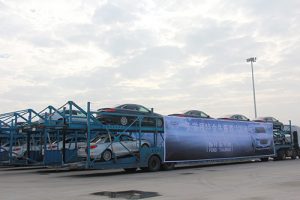 Ford's diverse model mix of different-sized SUVs and sedans, including the Taurus out of the Hangzhou plant, makes load building more complex
Ford's diverse model mix of different-sized SUVs and sedans, including the Taurus out of the Hangzhou plant, makes load building more complexmid-sized Edge SUV and the new Taurus sedan, the latter of which hit Chinese dealers in December. The four CAF plants, together with the JMC Xiaolan plant that builds Transit vans in Nanchang, south of Wuhan, and heavy-duty trucks in Taiyuan, in the north-east, have expanded Ford’s total production capacity to 1.9m units in Mainland China. CAF is also in the process of purchasing a factory from Hafei Automobile in Harbin, in the far north-east, that is expected to launch in 2016, but for which few details have been disclosed thus far.
In this expanded network, planning has become more important for vehicle logistics. Richard Li points out that the vehicle model mix requires more careful load building to maintain load factors for trucks and rail equipment.
Distribution from Hangzhou has also been combined in a “shared CAF network” with the Chongqing locations, says Bob Laurila, although they are more than 1,600km away from each other. Together with Ford, CAF introduced several vehicle mixing centres around areas like Beijing, Shanghai and Guangzhou to improve truck and rail loading.
“With Hangzhou our thought process changed entirely, and some of our transport modes changed to make us less reliant on over-the-road, and to turn more to rail and barge,” he says.
The developments in multimodal logistics are significant. With its plants in the west, in Chongqing, but large markets on the east coast, CAF has long used barge along the Yangtze River for part of its distribution, but relied on road for 75% or more of vehicle transport, while the JMC plants (which have a separate network) have used 100% road. Today, with more plant locations and markets developing across the country, Ford has diversified its transport mix, at least for CAF.
"We have been in discussions over the past year with [Changan Ford] about using [Ford] global IT systems so that we can increase data visibility on vehicles moving in China. It could come into scope in future." - Richard Li, Ford Asia Pacific
“While road is still more than 50% of our conveyances in China, we are growing rail and we have diversified substantially,” says Laurila. “Rail’s share is still relatively small – and less than barge – but it is moving in the right direction.
“JMC remains entirely road dependent, but in the future we may look to increase rail here as well,” he adds.
This modal mix could become more important, especially with a regulatory change expected next year that will set new standard lengths for car carriers in China, while cracking down on the use of overloading that is common among many providers, putting more pressure on trucking capacity and costs.
 Key imports to China and Asia Pacific, such as the Mustang from the US, have led Ford to allocate more resources to vehicle logistics management in the region
Key imports to China and Asia Pacific, such as the Mustang from the US, have led Ford to allocate more resources to vehicle logistics management in the regionFord has already seen some transport capacity issues in China related to its new plant and model launches, according to Richard Li. Although China saw weaker industry sales during parts of 2015, the complexity of flows and vehicle model mix led to shortages. A tax cut for vehicles with 1.6-litre engines or smaller also revived sales by the end of the year, a segment that represents 70% of Ford’s line up in China.
In response, Richard Li says Ford has encouraged its strategic logistics provider to invest in more trucks and to work with a broader array of carriers. For CAF, logistics are principally with a Changan-owned logistics entity, Changan Minsheng, and its affiliates, however with the growth in volume, the provider has extended its pool of subcontractors for trucking and barge services.
Ford has also worked with the state-owned China Railway Special Cargo Services to increase capacity, which has since invested in “a significant number of wagons” to support volumes from Ford’s plants, adds Li.
India: Strategic export hubIndia’s domestic market has moved in fits and starts for Ford, as the passenger vehicle market stagnated for several years. The country’s infrastructure is a perennial issue, including for its export competitiveness. Richard Wyatt points to the difference with Thailand, where Ford’s plants in Rayong are a similar distance to the port of Laem Chabang as the Chennai plant is to its local port of exit.
“Moving from the plant to the port in Chennai, we get one trailer turnaround every 24 hours, while in Thailand we get a minimum 4.5 turnarounds per day,” says Wyatt. “That adds cost since you need more trucks to shift your inventory.”
However, Bob Laurila makes it clear that Ford retains big plans for India. “We see India as a strategic export hub, whether that is going to be for components or finished vehicles. It is critical for us in the long term,” he says.
That vision is already taking shape with a strong production and logistics base. The Sanand plant increased Ford’s annual capacity in India to 440,000 units and added an export platform in the north-west. With volume exports of the Figo already going to Mexico from Sanand, the carmaker has also taken steps to improve its export network. It already integrated India into GVDS, for example. Earlier in 2015, it worked with NYK and its partner, APM Terminals, to launch an export facility and PDI centre at the port of Pipavav in Gujarat, 300km from the plant. “Pipavav is becoming a fully fledged ro-ro port, and NYK has done a great job,” says Wyatt. “It is a real showcase for ro-ro in India.”
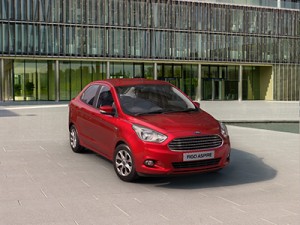 With its new plant in Sanand, Ford is growing Indian exports to markets such as Mexico and Africa
With its new plant in Sanand, Ford is growing Indian exports to markets such as Mexico and AfricaIn the domestic market, Sanand has opened up more routing and load-building opportunities between India’s north-west and Chennai in the south. Ford has also been slowly increasing its use of rail in India following government reforms that have spurred wagon investment.
“We are moving distribution out of Chennai by rail. It is a small percentage, but it is growing and it has been effective both from a cost and operational perspective,” says Laurila. “We have also started to run small volumes by rail out of Sanand. I believe that we are out ahead of some other carmakers in India with rail,” he adds.
Richard Wyatt says that his team is working with Ford’s sales and marketing teams to put robust plans behind rail and the possibility of coastal shipping in India, which the carmaker has yet to try. “We are looking to increase rail in India dramatically, and with multimodal potential our logistics are all up for grabs,” he says. “But it is still a tremendous challenge moving thousands of vehicles each month to ports in India.”
Laurila admits that India’s logistics need constant attention, especially in the country’s low-cost, low-margin car market, but he believes Ford is well positioned to compete in sales and exports, with logistics playing a supporting role. “We have good partners in India, whether it is for yard management, carriers or at ports,” he says. “They are very competitive.”
Thailand: World-class handlingIf India is to be a major export hub for Ford, Richard Wyatt hopes it will eventually look more like Thailand for logistics. Ford has had its AutoAlliance plant for 20 years, which builds the Ranger pickup and the Everest SUV, and opened its second plant in Rayong in 2012. For Wyatt, Thailand is not just competitive in manufacturing, but it is world-class for export logistics, especially at the port of Laem Chabang.
He points to top-notch terminal service, fast turnaround for ships and trucks, and skilled labour. “The Japanese ro-ro carriers have got Laem Chabang all sewn up, and you can see Japanese discipline from the time the vehicle is unloaded from the carrier to the time it is put onto a ship,” he says.
"The Japanese ro-ro carriers have got Laem Chabang all sewn up, and you can see Japanese discipline from the time the vehicle is unloaded from the carrier to the time it is put onto a ship." - Richard Wyatt, Ford Asia Pacific
Wyatt points to the port’s impressive quality KPIs. In the two-and-a-half years that he has been in Thailand, for example, not a single Ford has been damaged at Laem Chabang. “The port is complemented by excellent carriers, not only the Japanese but also ACT and WWL. The frequency of sailings is very high,” he says. “We have 7-8 sailings per month to Australia, along with weekly sailings to Vietnam, Malaysia, and elsewhere in Asia.”
Though Thailand has had its share of recent problems, including a political coup and social unrest, Ford has increased volume from its plants over the last two years. Laurila anticipates exports from Thailand to grow further, and Ford will need the right resources.
“As we expect significant growth, we were concerned about capacity at Laem Chabang, but we are working with providers to have the right service in place,” says Bob Laurila. “So far it has been very positive for Ford.”
Moving with the currentsPart of the vibrancy of Asia Pacific is its diversity of markets, from low-cost, emerging markets like Indonesia, to mature markets like South Korea, Australia and New Zealand. These island or peninsula nations also require careful logistics attention, especially for shipping. Ford uses seven different ports around Australia alone, for example.
Ford has been hit by the structural costs ‘Down Under’ that have pushed other OEMs from local production in Australia; it will close its plant in Broadmeadows, near Melbourne, in October 2016 (GM and Toyota are doing the same). Laurila admits that the shutdown, combined with other economic factors, have hurt sales in the short term, with exceptions for products like the Ranger imported from Thailand.
However, Ford is aggressively refreshing its model line up in Australia. “We plan to bring in a lot of products from Europe and Thailand, and managing our import processes will be very important as Australia is a very good market,” he says. Ford has also started importing a right-hand drive Mustang to Australia and New Zealand for the first time.
 Australia is an example of the important tasks facing Ford’s logistics across Asia Pacific, including securing frequent ro-ro sailings and reliable port processing. Just as with Indian and Thai exports to Asia and Europe, it will be critical to maintain strict control and visibility across the pipeline, something that GVDS, which will come to Australia in 2016, should improve.
Australia is an example of the important tasks facing Ford’s logistics across Asia Pacific, including securing frequent ro-ro sailings and reliable port processing. Just as with Indian and Thai exports to Asia and Europe, it will be critical to maintain strict control and visibility across the pipeline, something that GVDS, which will come to Australia in 2016, should improve.
The region’s import and exports will require considerable attention over the coming years. In many ways, Bob Laurila ranks that as a bigger task for vehicle logistics than China’s huge domestic volumes, which he sees as relatively stable. In particular, Lincoln offers MP&L an important potential to improve and grow. For 2016, Ford will more than double its Lincoln dealer network to 60 sales sites in 50 cities, with five different models. Plans beyond that are even more ambitious.“It will be critical for us,” says Laurila.
Transparent logistics are part of these ambitions. Lincoln and other imports form a channel in China over which Laurila and the MP&L team have strong control; from visibility and planning, to overseeing processing through a major terminal at Shanghai Haitong port. As volumes rise, Ford may diversify its port options and wider transport network.
Perhaps more importantly, products like Lincoln and Mustang have a strong brand resonance and require the highest customer service levels, which MP&L can make or break. With a dedicated vehicle logistics team, global systems and best practices from across Asia Pacific and around the world, the carmaker at least has the resources to reach this potential and maintain similar service across the region.






